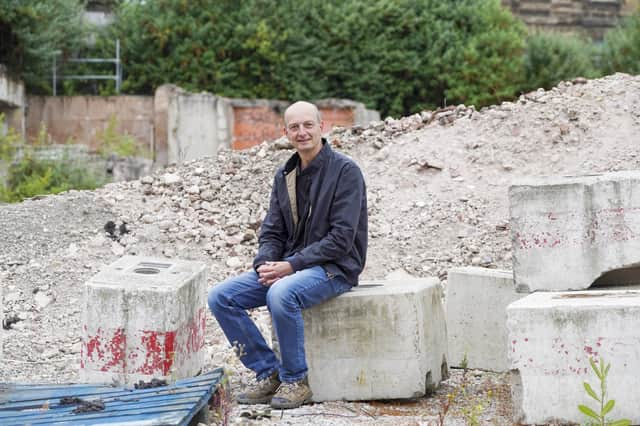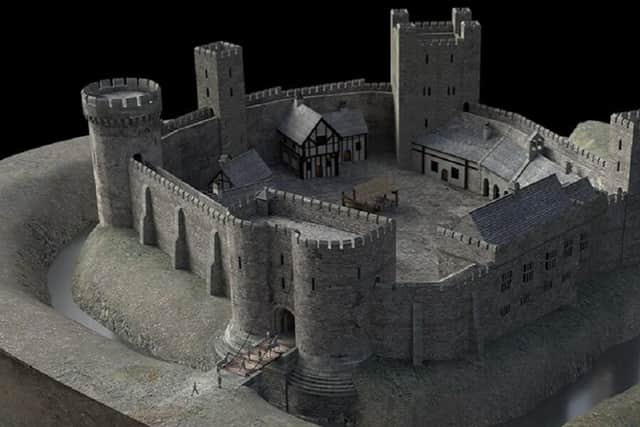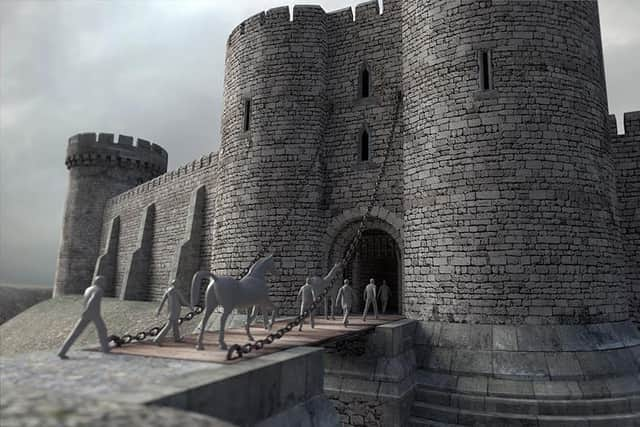Sheffield Castle volunteers finally get to revisit 'most precious part of city's past' after 18 months away from site


But beneath the man cover and down, deep down into the ground, is an inaccessible chamber that contains fascinating excavated remains of Sheffield Castle, where the city first began.
"We’re stood on the drawbridge here”, smiles Martin Gorman, chairman of the Friends of Sheffield Castle, as he uses a visualisation of the castle to bring history to life.
Advertisement
Hide AdAdvertisement
Hide Ad"What is beneath us is part of the base of the towers. We think there are even more of the remains nearby.”


Monday was the first time that the archaeological site and its two chambers have been able to be visited in 18 months, thanks to the Covid-19 pandemic, and they were last seen as part of the popular heritage open days which took place in 2019.
Martin added: “It's where Sheffield began but you do have to be really creative with your mind to see it. “When we do tours here it is like you are taking them around a demolition site!”
We were indeed stood on a demolition site, as the former Castle Market stood over the castle remains until it was closed then knocked down from 2015.
Advertisement
Hide AdAdvertisement
Hide AdBut as Martin describes the drawbridge pier, how the castle faced out towards Manor Lodge with the city stretching behind it up to Sheffield Cathedral, the noise of the Waingate traffic fades away, and you can imagine the clop of hooves instead, of people living inside the castle walls.


It has long been hoped that more people will be able to uncover the story of Sheffield Castle – which dates back to 1120 when the first motte and bailey castle structure was thought to have been built - than just those few hundred who attend heritage open days.
There is much for people to discover and debate, not least how the castle connected to the parts of the city centre that surround it today. Looking over one wall, down onto where slaughterhouses used to be, now shows stunning flowerbeds lining the riverside and smart apartments.
And there are questions over how the castle moat worked, and if it connected or emptied into to the city rivers. A walk to the second chamber takes us past where an 18th century bowling green once stood.
Martin adds: “It’s like a massive detective story.”
Advertisement
Hide AdAdvertisement
Hide AdRuth Morgan, a committee member of the Friends group, said the castle was something of a ‘test case’ and it was a ‘crucial time’ for Sheffield’s heritage.
The proposed closure of the University of Sheffield’s archaeology department is a blow to the Friends group, as staff have worked on excavations at the site in the past, revealing important information and remains.
Ruth, also secretary of the Hunter Archaeological Society, said of what she would like to see the site become: “I wouldn’t want it to become an office development – it needs to have an element of open space. “The remains should be visible.
"It would be great to have some green space where people want to come and sit and enjoy the view and the history.”
Advertisement
Hide AdAdvertisement
Hide AdInside the second chamber, we saw some of the important remains that have revealed much about the castle. A right angle in stone reveals what was a staircase, marks on others show how masons stamped their handicraft centuries ago. The inside of walls and bases of a pillar are collected together.
A window set in the floor once showed undisturbed beams below, believed to have been part of the hall of Waltheof. It was 1086 when the Domesday Book records Earl Waltheof, Lord of Hallamshire, having a hall, believed to be on the site of the later castle.
There’s also a possibility that Mary Queen of Scots stayed in this part of the castle when she was held captive in the city – and many of the mason’s marks appear to show an M.
Martin added: “When Mary was here Sheffield suffered an earthquake and her room moved, so they had to move her into another room.
Advertisement
Hide AdAdvertisement
Hide Ad"There is such a lot of information about the castle but what we haven’t got is a plan. That’s the frustrating thing. It’s the most precious part of Sheffield’s past.”
As the Telegraph went to press yesterday, it was revealed Sheffield Council had submitted a bid to the Government’s Levelling Up Fund for three projects to transform under-used areas of the city centre including Castlegate.
Castlegate would be revived as a focal point of the city by de-culverting the River Sheaf and introducing new greenery and dedicated public spaces, as well as preparing the land around the site for future uses.
The site would be sensitively developed in accordance with its important historic past, with the preservation of archaeology a priority.
Advertisement
Hide AdAdvertisement
Hide Ad"We would want the public to be consulted on any plan”, adds Martin.
"For a developer to get interested the site would need to go through various improvements, hopefully that means we could do some more archaeology as there is such a lot of the site we know nothing about.”
The Friends have organised castle heritage open days on September 18-19.